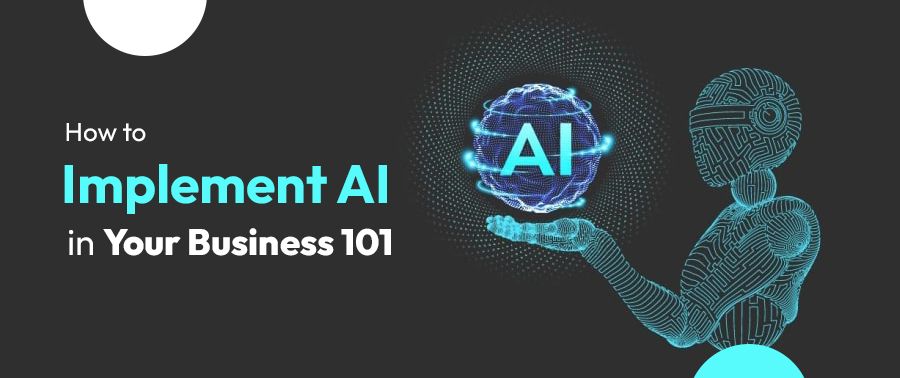From ChatGPT to Google’s Bard AI, and from speech recognition to natural language recognition, Artificial Intelligence (AI) has been the talk of the town lately. With the world of technology taking gigantic strides, these technological advancements prove to be significantly beneficial in the ever-changing business landscape.
From automating repetitive tasks to analyzing, bundles of data, AI can help a business gain a competitive edge in its industry. We have all heard about how AI has the potential to alter and enhance the way businesses operate today. But, when it comes to ground zero, the implementation, there is a grey area.
Business owners are not very clear on how and where to begin. Let us first have a brief idea about why in 2023 is it necessary for business owners like you to adopt AI models: -
- Carrying out repetitive tasks such as data entry
- Conducting admin tasks such as sending out reminders and scheduling meetings
- Assisting marketing professionals by executing email campaigns, and various other tasks as well
The core purpose of the use of AI is to save time and money. As soon as you automate tasks, they are finished quicker and you do not need to hire as many men as earlier. Talk about a win-win!
Further in this blog, you will learn about
- Requirements for implementing AI in your business
- Step by Step guide to implementing AI in a modern-day business
Let’s get digging!
Requirements for implementing AI in any business
Before you kick off your AI implementation campaigns, there are a couple of things to check
- If you have enough data for AI tools to analyze and function
- What are your existing technological capabilities
Think of data as raw fuel for AI models to run on. AI comprises algorithms that are formed when they analyze patterns of data. This data is then used for training AI models that can then carry out predictive analysis for your business.
The larger the amount of data available, the better the algorithm, and thus more accurate will be the predictive results. At the same time, you must look into your pockets and figure out if you have enough in-house personnel to carry out this implementation task or if it would be wiser to outsource it to a team of tech professionals.
The reason why you need to make such checks before starting the project is so that the work does not stop midway. Else, it may lead to the wastage of resources.
It is now time to get down to the main task.
Step-by-Step Guide to Implementing AI in Business
For ease of understanding and especially ‘implementation’ we will break down this entire process into a flow of steps.
Establishing well-defined business goals –
AI is very powerful, but it isn’t a genie. It is important that prior to introducing AI models in your business, you define what your goals and expectations are. This will help provide a sense of direction to your project. Your goal may be to
- Increase market reach by conducting deeper market research
- Receiving better customer feedback on the fronts of customer service through the introduction of chatbots and virtual assistants
Identifying business areas where AI can prove to be beneficial
This is a crucial step for maximizing the potential of AI in your business. Of all the different departments in your business structure, narrow down the ones that will benefit the most from the implementation of AI.
For instance, depending upon your business model it may so happen that your marketing department is in dire need of a push, so implement AI models there and see the change.
How will AI help the marketing team? Well, for starters, it will analyze previously available customer data and weave out patterns. It will then use Machine Learning algorithms to construct personalized marketing messages based on the data patterns obtained. The result of this project will be a higher customer conversion rate, leading to a rise in revenue for the business.
Build a team of in-house and outsourced experts –
While the decision of team composition largely depends upon the budget and resources of the business, the ideal scenario would be an amalgamation of in-house individuals and outsourced experts.
Why? With AI being a relatively new field of technology, there is a high chance that your company may not have an expert in this field. But, at the same time, it is not wise to completely outsource the work. A mixed team results in top skills being invested in the project by the outsourced individuals while the in-house team members ensure that the AI project is in line with the company values and morals.
Moreover, a combined effort results in faster work with inputs coming in from multiple backgrounds, and the company’s employees also have a chance to learn more about this technology of the future.
Using appropriate AI-based tools and technologies –
Now this is where the actual task takes place. There is tons of software and a variety of applications available for every dedicated task. We will list out some of the most popular AI models used for some of the most common day-to-day business tasks.
For instance, when it comes to Email marketing, you can use tools such as HubSpot, Constant Contact, and Mailchimp.
For handling Social Media, you can use Sprout Social, Hootsuite and Socialbakers.
For Data Analytics you can employ Mixpanel, Google Analytics, or Adobe Analytics.
For fulfilling your Copywriting needs, AI tools such as Conversion.ai, Jasper, and ChatGPT work best.
For optimizing the HR Department of your company, integrate it with AI tools such as Workable, Workday, and ThriveMap.
When it comes to Image Generation, you can use tools such as DALL-E, Midjourney, and Canva.
Similarly, there are dedicated tools for various work purposes including Copy Editing, SEO, Sales, Plagiarism Checks, Customer Support, AI Assistant, and Customer Rate Optimization among several others.
Measure KPIs regularly to adjust your approach –
You are now down to the last piece of this maze. To stay ahead of your competitors, it is important that you constantly analyze the output of the implementation of the AI models and make certain tweaks here and there to increase their effectiveness.
Staying within the feedback, improvement, feedback, and improvement loop is necessary.
To conclude, the implementation of AI in your business or workflow is no longer a luxury but a need of the hour. With the business dynamics evolving with every passing minute, it is difficult to stay on top of every development, and this is where AI comes in handy. It can harness its computing power to analyze past data and present trends, to conduct predictive analysis for your business.
But at the same time, the implementation of AI isn’t a cakewalk. It requires a well-researched data-driven approach so that you are not only effective but also sustainable in your approach.
So, it is time you get down to business and accelerate your work with the assistance of AI.







Top comments (2)
Ai is also useful for advertising and its optimization. There are many important issues in Google Ads including Google Ads Conversion Value. But thanks to AI, analyzing all these factors is easier. I recommend this post about Google Ads: gamerseo.com/blog/what-is-conversi...
Developing HR software involves several steps to ensure that the software meets the needs of HR professionals and the organization as a whole. _Here's a general roadmap to guide you through the process:_